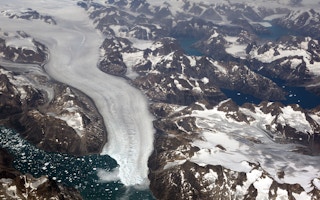A massive Greenland glacier that holds enough water to raise sea levels by half a metre is melting at speed, according to a new study.
The Zachariae Isstrom in northeast Greenland has entered a phase of accelerated retreat, and is losing mass at the rate of 5 billion metric tons a year, according to US scientists.
They report in the journal Science that a succession of aerial surveys combined with multiple satellite observations has established that the base of the glacier is being eroded rapidly by a mix of warmer ocean water and increasing amounts of meltwater from the surface of the Greenland ice sheet.
“North Greenland glaciers are changing rapidly,” said Jeremie Mouginot, an earth system scientist at the University of California, Irvine, who led the study.
“The shape and dynamics of the Zachariae Isstrom have changed dramatically over the last few years. The glacier is now breaking up and calving high volumes of icebergs into the ocean, which will result in rising sea levels for decades to come.”
“
The changes are staggering and are now affecting the four corners of Greenland.
Eric Rignot, professor of earth system science at University of California, Irvine
Latest alarm
This is just the latest in a series of alarms about the state of the Greenland ice cap: researchers confirmed last year that the Jakobshavn Isbrae in west Greenland, the fastest flowing river of ice on the island, had doubled in speed and then doubled again in this century, and was now moving at 46 metres a day, or 17 kilometres a year.
A Danish team last year also raised concern about the 600-kilometre Zachariae ice stream, and confirmed that ice loss in the northeast of the island was accelerating.
So the University of California study delivered a closer look and made a more precise measurement of the flow from the ice cap to the sea. Altogether the scientists looked at 40 years of measurements. After 25 years of relative stability, the glacier began to pick up speed at the turn of the century.
North Atlantic Ocean temperatures rose by 1°C between 1997 and 2010. Between 2012 and 2015, the Zachariae ice stream accelerated by 125 metres a year, every year, three times faster than the speed between 2000 and 2012.
The researchers predict that the Zachariae glacier will go on retreating for another 20 to 30 years, while continuing to increase its discharge of ice.
“Zachariae Isstrom is being hit from above and below,” said Eric Rignot, professor of earth system science at UC, Irvine and another of the authors.
“The top of the glacier is melting away as a result of decades of steadily increasing air temperatures, while its underside is compromised by currents carrying warmer ocean water, and the glacier is now breaking away into bits and pieces and retreating into deeper ground.”
The Zachariae glacier’s neighbour, called Nioghalvfjerdsfjorden, is also melting rapidly, but retreating at a slower rate. The two glaciers between them account for 12 per cent of the island’s ice sheet, and if both collapsed into the sea and melted entirely, global sea levels would rise by about a metre.
“Not long ago, we wondered about the effect on sea levels if Earth’s major glaciers were to start retreating,” said Professor Rignot.
“We no longer need to wonder; for a couple of decades now, we’ve been able to directly observe the results of climate warming on polar glaciers. The changes are staggering and are now affecting the four corners of Greenland.”








